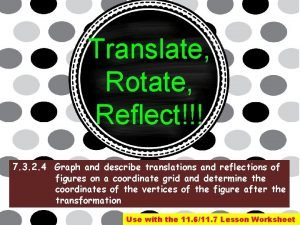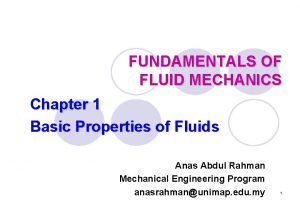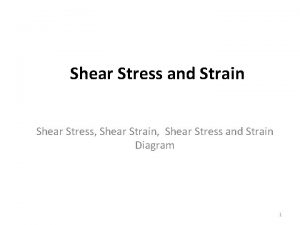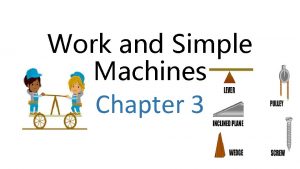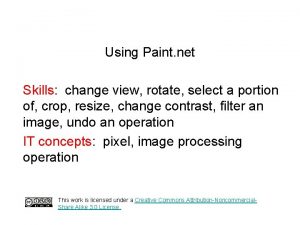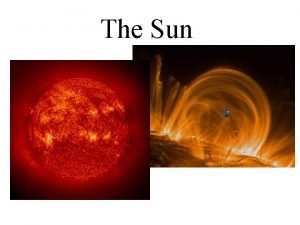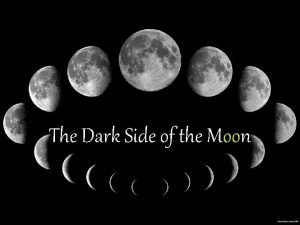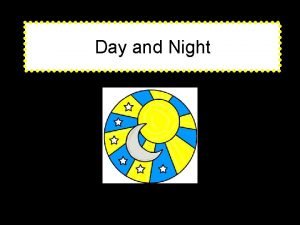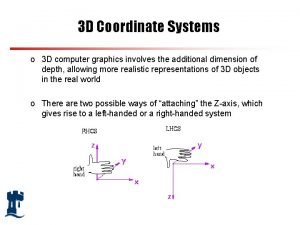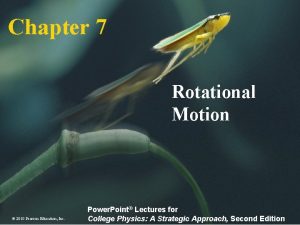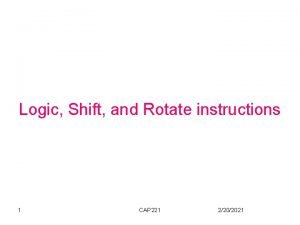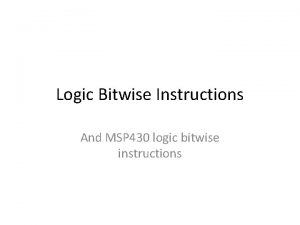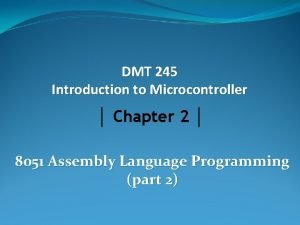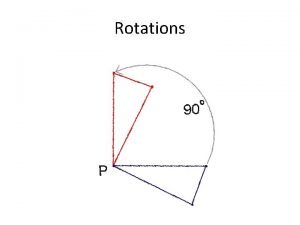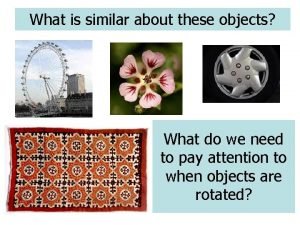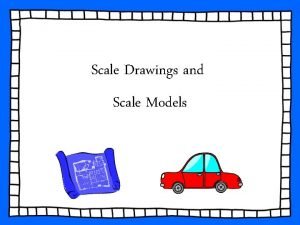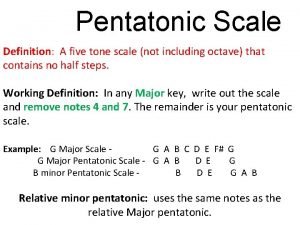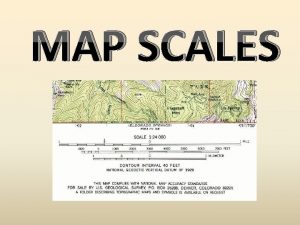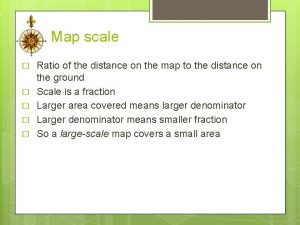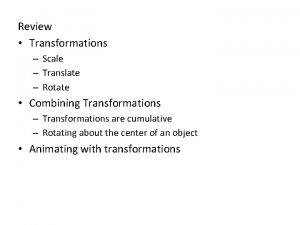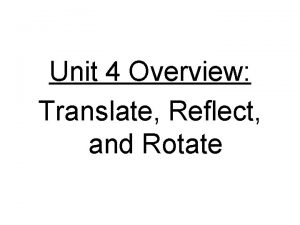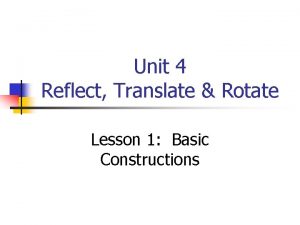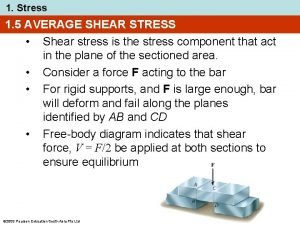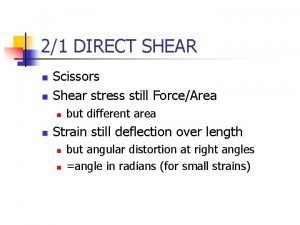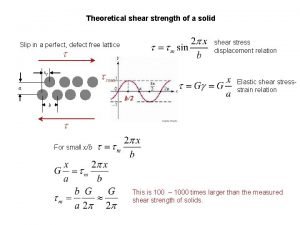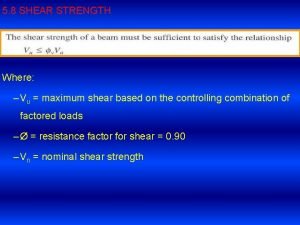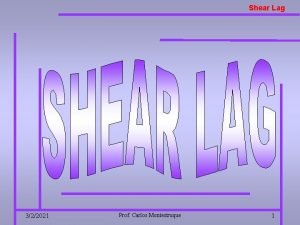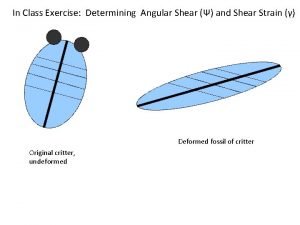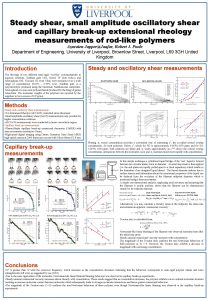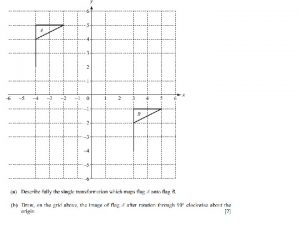Transforms Types of Transforms Translate Rotate Scale Shear





![Matrices • Rectangular arrangement of numbers • [1 2 3] 2 -3 0 3 Matrices • Rectangular arrangement of numbers • [1 2 3] 2 -3 0 3](https://slidetodoc.com/presentation_image_h2/568cc6928fe1f5a877e72ddf66307baf/image-6.jpg)

![Multiplying Matrices 3 [4 5 6] x 2 = 4*3 + 5*2 + 6*1 Multiplying Matrices 3 [4 5 6] x 2 = 4*3 + 5*2 + 6*1](https://slidetodoc.com/presentation_image_h2/568cc6928fe1f5a877e72ddf66307baf/image-8.jpg)


![Scaling (12, 8) (3, 2) [3 2] 4 0 = [12 8] 0 4 Scaling (12, 8) (3, 2) [3 2] 4 0 = [12 8] 0 4](https://slidetodoc.com/presentation_image_h2/568cc6928fe1f5a877e72ddf66307baf/image-11.jpg)

![Reflection [ 3 2] -1 0 = [-3 -2] 0 -1 (3, 2) (-3, Reflection [ 3 2] -1 0 = [-3 -2] 0 -1 (3, 2) (-3,](https://slidetodoc.com/presentation_image_h2/568cc6928fe1f5a877e72ddf66307baf/image-13.jpg)






![Transformations [ 3 2 ] + [ 2 4] = [5 6] (5, 6) Transformations [ 3 2 ] + [ 2 4] = [5 6] (5, 6)](https://slidetodoc.com/presentation_image_h2/568cc6928fe1f5a877e72ddf66307baf/image-20.jpg)

![Homogeneous Translation 1. Add a 1 to the point vector [3 2 1] = Homogeneous Translation 1. Add a 1 to the point vector [3 2 1] =](https://slidetodoc.com/presentation_image_h2/568cc6928fe1f5a877e72ddf66307baf/image-22.jpg)







- Slides: 29

Transforms

Types of Transforms Translate Rotate Scale Shear

Affine Transform Math • Transforms are cumulative • Transforms change the whole world view • Order matters!

Rotate 90 Reflect X

Making Shapes work together • Create an object that has state variables corresponding to its parts • Draw from the center of the overall object • Perform transforms: 1. translate to center of overall object 2. rotate if wanted 3. scale/shear if wanted
![Matrices Rectangular arrangement of numbers 1 2 3 2 3 0 3 Matrices • Rectangular arrangement of numbers • [1 2 3] 2 -3 0 3](https://slidetodoc.com/presentation_image_h2/568cc6928fe1f5a877e72ddf66307baf/image-6.jpg)
Matrices • Rectangular arrangement of numbers • [1 2 3] 2 -3 0 3 7 -1 • Dimensions • Diagonal • Transpose: interchange rows and cols • Identity: Square matrix, diagonal is ones, rest is zeros

Matrix Operations • Adding and subtracting: matrices must have same dimensions • Add or subtract element-wise [1 2 3] + [4 5 6] = [5 7 9] • Scalar multiplication: multiply all elements by the scalar 2 * [1 2 3] = [2 4 6]
![Multiplying Matrices 3 4 5 6 x 2 43 52 61 Multiplying Matrices 3 [4 5 6] x 2 = 4*3 + 5*2 + 6*1](https://slidetodoc.com/presentation_image_h2/568cc6928fe1f5a877e72ddf66307baf/image-8.jpg)
Multiplying Matrices 3 [4 5 6] x 2 = 4*3 + 5*2 + 6*1 = [28] 1 (m x n) x (n x p) yields (mxp) Even if the matrices are square, multiplication is not commutative

Matrices and Graphics • A point can be described (3, 2) using a vector: p = (x, y) p = xi+yj • Or a matrix: [x y] • Transposes are matrices that get postmultiplied to the point to produce a new point.

Scaling • Multiply by the matrix a 0 where a is the scale 0 b factor in the x direction, and b is the scale factor in the y direction • If a and b are the same, it’s like multiplying by a scalar. (Balanced or Uniform scaling)
![Scaling 12 8 3 2 3 2 4 0 12 8 0 4 Scaling (12, 8) (3, 2) [3 2] 4 0 = [12 8] 0 4](https://slidetodoc.com/presentation_image_h2/568cc6928fe1f5a877e72ddf66307baf/image-11.jpg)
Scaling (12, 8) (3, 2) [3 2] 4 0 = [12 8] 0 4

Reflecting • Reflection in the x–axis: 1 0 0 -1 • Reflection in the y–axis: -1 0 0 1 • In general, multiplying by negative numbers combines a reflection and a scale.
![Reflection 3 2 1 0 3 2 0 1 3 2 3 Reflection [ 3 2] -1 0 = [-3 -2] 0 -1 (3, 2) (-3,](https://slidetodoc.com/presentation_image_h2/568cc6928fe1f5a877e72ddf66307baf/image-13.jpg)
Reflection [ 3 2] -1 0 = [-3 -2] 0 -1 (3, 2) (-3, -2)

Rotations: Searching for a Pattern -1 0 rotates through 180 degrees 0 -1 (pi radians) 1 0 rotates through 360 degrees 0 1 (2 pi radians) 0 1 causes a rotation of 90 degrees -1 0 (pi/2 radians) 0 -1 causes a rotation of 270 degrees 1 0 (3 pi/2 radians)

In general… • The pattern emerges: To rotate through an angle Ө, multiply by cos Ө sin Ө -sin Ө cos Ө

Transforming Polygons • To transform a line, transform its end points and connect the new points. • Polygons are collections of lines. • Multiplying several points is the same as making a matrix where each point is a row. • True for Affine Transformations – preserves points on line and parallelism – preserves proportions (i. e. , the midpoint remains the midpoint)

Transforming Polygons R*(18, 8) P*(3, 6) 13 30 64 R(6, 4) P(1, 3) Q(3, 0) Q*(9, 0) 30 36 02 = 90 18 8

Multiple transformations • Order in transformations matters. • Matrix multiplication is not commutative!

Translations • To translate, we add rather than multiply matrices. • To shift a point over by a in the x direction and b in the y direction, add the matrix [ a b]
![Transformations 3 2 2 4 5 6 5 6 Transformations [ 3 2 ] + [ 2 4] = [5 6] (5, 6)](https://slidetodoc.com/presentation_image_h2/568cc6928fe1f5a877e72ddf66307baf/image-20.jpg)
Transformations [ 3 2 ] + [ 2 4] = [5 6] (5, 6) (2, 4) (3, 2)

Homogeneous Coordinates • You can’t use a 2 x 2 multiplication matrix to model translation. Bummer! • But, we can add a third dimension of homogeneous coordinates, and now all 2 D transformations can be expressed in a 3 x 3 matrix.
![Homogeneous Translation 1 Add a 1 to the point vector 3 2 1 Homogeneous Translation 1. Add a 1 to the point vector [3 2 1] =](https://slidetodoc.com/presentation_image_h2/568cc6928fe1f5a877e72ddf66307baf/image-22.jpg)
Homogeneous Translation 1. Add a 1 to the point vector [3 2 1] = (3, 2) 2. To translate over 2 and up 4, multiply by 1 0 0 0 1 0 2 4 1 [3 2 1] 1 0 0 0 1 0 2 4 1 = [5 6 1]

Homogeneous Scale • Scale by a in x direction and b in y a 0 0 0 b 0 0 0 1 • Reflect in x-axis: 1 0 0 0 -1 0 0 0 1

Homogeneous Rotation • Rotate about the origin: cos Ө sin Ө 0 -sin Ө cos Ө 0 0 0 1

Rotation about a point • How would we rotate about a point other than the origin? I want to rotate this shape about its center, which is (5, 2).

Rotation about a point • Step 1 – translate coordinates so that your point of rotation becomes the origin. 1. 1 0 -5 Multiply by: 0 0 1 0 -2 1

Rotation about a point • Step 2 – Do your rotation 2. (For 90 degrees) Multiply by: 0 1 0 -1 0 0 1

Rotation about a point • Step 3 – go back to original position 3. Undoing step 1: 1 0 0 0 1 0 5 2 1

3 D • How do you think it is done in 3 D?
 Reflections on a coordinate plane worksheet
Reflections on a coordinate plane worksheet Fluid mechanics chapter 1
Fluid mechanics chapter 1 Shear stress and shear strain diagram
Shear stress and shear strain diagram Two wheels of different sizes that rotate together
Two wheels of different sizes that rotate together Paint.net rotate image
Paint.net rotate image Does the sun rotate
Does the sun rotate Revolve vs rotate
Revolve vs rotate Scratch pico
Scratch pico Study jams a day on earth
Study jams a day on earth Axis of rotation
Axis of rotation 2010 pearson education inc answers
2010 pearson education inc answers Squid log rotate
Squid log rotate Ah?
Ah? Bitwise xor
Bitwise xor Rotate and swap instruction in 8051
Rotate and swap instruction in 8051 Which bird can rotate its neck backwards to a large extent
Which bird can rotate its neck backwards to a large extent Fast does the earth rotate
Fast does the earth rotate Does the sun rotate around the earth
Does the sun rotate around the earth Fast does the earth rotate
Fast does the earth rotate Does the moon rotate
Does the moon rotate What is a tire rotation
What is a tire rotation How to rotate coordinates 90 degrees
How to rotate coordinates 90 degrees Does the moon rotate
Does the moon rotate Rotate 90 degrees counterclockwise
Rotate 90 degrees counterclockwise Rotate image gfg
Rotate image gfg Small scale map
Small scale map Technical drawing vocabulary
Technical drawing vocabulary Down the tone scale
Down the tone scale Map scale
Map scale Map scale ratio
Map scale ratio
